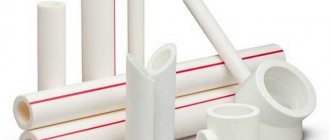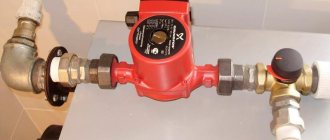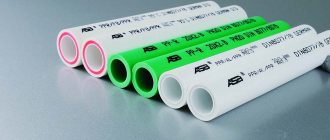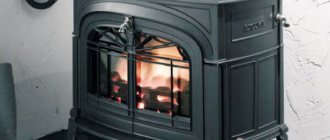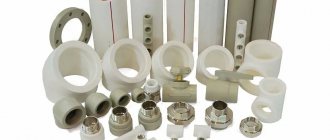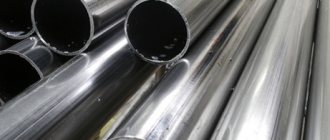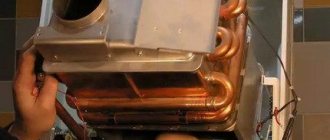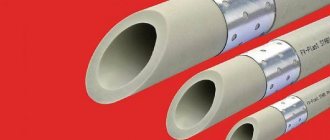A variety of materials are used for laying communication systems necessary for heating air in residential and business premises. It is worth carefully considering one of the most popular options - polypropylene pipes for heating.
They are in some ways inferior to steel and metal-plastic products, but in a number of indicators they surpass their characteristics. In this article we will take a detailed look at the existing types of polypropylene pipes, features of their marking, advantages and disadvantages of use.
We will also pay attention to the installation of a polypropylene pipeline and focus on the secrets of welding pipes made of this material. In addition, we will consider the best manufacturers that supply the market with quality products at an affordable price.
Polypropylene and its properties
Polypropylene (PP) is a polymer that is part of the group of thermoplastics, that is, substances whose properties change depending on the ambient temperature.
At 140 °C, products made from this type of plastic soften, and at 170 °C they melt. The maximum temperature for their use is 120 °C.
However, to be on the safe side, manufacturers usually indicate a permissible temperature of 90-95°C, since the combination of elevated temperature (115-120°C) with high pressure 6-7 kgf/m2 can be dangerous
When using PP products, it is important to take into account that this type of plastic has pronounced thermal expansion. At high temperatures, polymer parts can expand significantly, for example, the length of a three-meter pipe increases by 3 cm.
How to choose pipes
To install a heating system, it is better to purchase aluminum-reinforced pipes. It is important to follow the rules and read the symbols on the pipe. Keep in mind that the temperature will be quite high; you also need to select a pipe with the correct pressure in the system.
Marking of pipes for hot and cold water is applied to the product. For cold water, a regular polypropylene pipe marked PN 10 is suitable. Such a pipe is inexpensive, and if the operating rules are followed, it can last up to 100 years.
For hot ones, you need to choose pipes with fiberglass reinforcement. Suitable PN markings: 16, 20, 25. The operating temperature of such pipes is 95 degrees. At temperatures above 140 degrees, the pipe will fail or it will begin to melt. During installation, it is important to additionally reinforce the pipes to protect against deformation. The advantage of using polypropylene pipes for hot water supply:
- Service life up to 50 years;
- High cross-country ability;
- Noise absorption;
- Wear resistance;
- Resistance to temperature fluctuations.
You can install polypropylene pipes yourself and without special skills. To do this, it is important to know the markings and not combine products with different compositions. Docking is done using special fittings and flanges.
In order for the system to last a long time, you must follow all the rules of operation, proper installation and combination of the pipes and connections themselves. It is also important to choose a reliable manufacturer; if the product is too cheap, this should alert you, after all, the system is not made for one year. With high-quality pipes, you can easily carry out repair work in small areas without having to change the entire system. To do this, leave the marking until the end, do not erase or degrease it. When purchasing, do not hesitate to check the information with the seller; a good store will offer you high-quality pipes from leading manufacturers and reliable fastenings to them.
Advantages of polypropylene pipes
Products made from this type of polymer have many advantages:
- have a complete structure without a longitudinal seam;
- plastic parts do not corrode;
- are light in weight, facilitating transportation and storage;
- can be used even at high pressure;
- easy to install, which allows you to assemble the structures yourself, without the involvement of professionals;
- polypropylene products can be used for a long time (50 years or more);
- the cost of such elements is lower than their analogues (steel, metal-plastic);
- have low thermal conductivity, which reduces heat loss to a minimum;
- do not freeze at sub-zero temperatures;
- they create virtually no hydraulic resistance, which allows the water flow to move without noise and vibration;
- polypropylene products are considered environmentally friendly, they do not emit harmful substances, and the water does not acquire foreign odors;
- such elements are hygienic: polymers do not contribute to the development of single-celled plants and microbes;
- Products made from polypropylene have an aesthetic appearance; they do not require painting or other finishing.
However, to take advantage of all these benefits, you need to choose the right pipes for water supply or heating.
What is polypropylene
This is an organic synthetic polymer - thermoplastic and non-polar. In 1957, this material began to be polymerized using a Ziegler-Natta catalyst, and its industrial production was established.
Although the material is plastic under the influence of high temperatures, in its normal state it has high strength, is chemically inactive, practically does not absorb moisture, and does not transmit electricity. It is suitable for distilling food liquids.
GOST for plastic pipes
Although there is no separate standard for polypropylene pipes, their quality and characteristics are noted in the unified GOST R52134-2003. It lists the standards relating to installation elements (pipes and fittings) made of thermoplastic materials that are used for heating communications and hot water supply.
These standards apply to products made from the following types of polymers:
- polybutene (PB, PB);
- polyethylene (PE, PE);
- chlorinated (PVC-C, CPVC) and unplasticized (PVC-U, uPVC) polyvinyl chloride (PVC);
- cross-linked polyethylene (PE-X, PE-S);
- polypropylene, polymers of the same group (block copolymer, homopolymer, random polymer).
The document also regulates the dimensional characteristics of pipes, conditions of use and various technical qualities, such as safety factor, maximum temperature/pressure indicators (they determine the category to which a particular product belongs).
GOST R 52134-2003, the development of which took into account international standards and requirements for thermoplastic pipes, can be used to assess the quality of polymer elements.
The standards are also useful for calculating the wall thickness of products: knowing the required operating conditions and the service life of the pipe, you can find out which parts are suitable in a particular case
It should be noted that GOST R 52134-2003 in no way contradicts GOST 18599 (standard for PE products) and GOST 51613 (standards for PVC), but complements them.
PP pipes are used for various construction works:
- when installing centralized heating;
- organization of boiler installations;
- cold/hot water supply installations;
- installation of risers;
- installation of "warm floor".
In addition, such elements can be used in agriculture for the construction of drainage systems and soil water disposal, as well as in industry for the transportation of chemicals, including aggressive media.
Additional data
In addition to the basic characteristics indicated, the marking of plastic pipes for hot water contains the following information:
- data on compliance with the requirements of international and domestic technical regulations;
- manufacturer – brand or trademark;
- name and number of the quality mark - this data confirms the product’s compliance with international standards;
- the type of production technology used and the minimum long-term strength (MRS) characteristic;
- production date, batch number and other information contained in the 15-digit code.
Types of propylene pipes
Since products made from this type of plastic are produced in a wide range, there are several types of classifications.
Various colors
The range of polypropylene pipes includes products of different colors. The most common mounting elements are white, green, gray and black.
As a rule, the shade of products is chosen arbitrarily and depends on the design of the pipes and manufacturers (some enterprises traditionally produce pipes of the same color, for example, green).
When choosing polypropylene pipes, you should also pay attention to the color of the products. This criterion is especially important if you plan to install an open system in living rooms or office spaces (bathroom, kitchen)
The only exception is plastic products of a radical black hue. As a rule, this color is an indicator of the maximum level of ultraviolet protection.
Constructions of various types
Based on their internal structure, all polypropylene pipes can be distinguished into two fundamental categories:
- single-layer, consisting of one layer of plastic;
- multilayer (reinforced) from several shells, which consist not only of plastic, but also of materials that strengthen the structure, creating a durable frame.
Reinforced structures are preferable to single-layer ones, since in this case the thermal elongation of the pipe is significantly reduced.
Types of multilayer pipes
There are several options for multilayer pipes. The most commonly used reinforcement materials are aluminum and fiberglass.
Schematic representation of a pipe reinforced with aluminum, indicating all layers, including adhesive ones. Such products are produced using a modern laser welding method.
Pipes reinforced with a continuous sheet of aluminum foil. When making such products, a smooth thin sheet of silver metal is applied to the outer side of the polypropylene blank.
Before installation, such pipes must be cleaned by cutting off the foil at a distance of approximately 1 mm from the edge. Skipping this process negatively affects the quality of the seam, which will turn out loose and unreliable.
Mounting elements, reinforcement with perforated aluminum sheet. One of the layers of such pipes is foil with holes punched in it. As in the previous case, before using such parts they should be cleaned.
It is important to note that products with perforated foil have a high oxygen permeability coefficient, so they should not be combined with heating boilers or similar equipment.
Pipes with a core reinforced with aluminum sheet. In this case, the products are reinforced in the middle or even the inner part, so you can do without stripping before starting work.
Fiberglass reinforced parts. The core of the pipe is most often made from this durable material, while its internal and external parts are made of polypropylene.
Pipes reinforced with fiberglass are deservedly popular. Such products are characterized by increased strength and rigidity, in addition, they can be used for welding without prior preparation
Composite reinforcement. For greater strength, the pipes also have a middle layer made of a combined material that combines polypropylene and glass fiber. Such pipes also have high consumer properties and do not require cleaning before use.
Despite the fact that the price of reinforced pipes is approximately 40% higher than single-layer pipes, they should be preferred for heating wiring. Multilayer products are highly reliable and durable, and they also have a more aesthetic appearance
A type of multilayer PP elements are pipes that contain an additional layer of plastic. Such products can withstand high temperatures well, but contact between the transported liquid and the reinforced layer cannot be ruled out.
In addition, the coatings in such products are often glued together with glue, which under certain conditions can lead to delamination.
Service class
When choosing domestically produced polypropylene products, the purpose of the pipe will indicate the service class according to GOST.
- Class 1 – the product is intended for hot water supply at a temperature of 60 °C.
- Class 2 – DHW at 70 °C.
- Class 3 – for underfloor heating using low temperatures up to 60 °C.
- Class 4 – for floor and radiator heating systems that use water up to 70 °C.
- Class 5 – for radiator heating with high temperatures – up to 90 °C.
- CW - cold water supply.
USEFUL INFORMATION: How to improve the external design of a bathroom: hide the pipes
Labeling of polypropylene products
All pipes made from this type of plastic are marked with a certain combination of letters and numbers, which contain comprehensive characteristics of such products.
Pipe material designation
The name of the manufacturer's company is usually written in the first place, followed by the type of material from which the product is made.
The presented diagram clearly shows the decoding of alphanumeric combinations that are applied to polypropylene products. As you can see, they are a real product passport
There are several types of plastic:
- PPH (PPH, PP-type 1, PP-1). Homopolyer is the simplest type of polypropylene, for which raw materials are used with a small amount of modifying additives that increase impact strength. Products in this category usually have a large diameter. They are used in ventilation, drainage, and external water supply (cold) systems.
- PPB (PP-type 2, PP-2, PPV). These letters denote a more complex type of PP - blocksomer, which is characterized by a special molecular structure. Thanks to this, plastic is characterized by increased resistance, which makes it possible to use it to create high-strength elements, install floor heating systems, and communications for cold water supply.
- PPR (PPRS, PPR, PP-3, PPR, PP-random). A type of polypropylene is a static copolymer (random copolymer). The crystalline arrangement of molecules in this material allows it to withstand wide temperature fluctuations, as well as shock loads. Copolymer pipes, the diameter of which can vary from 16 to 110 mm, are used for laying water supply, heating systems, and sewerage.
- PPs (polyphenyl sulfide). A polymer with enormous resistance to high temperatures and physical stress, as well as improved strength and wear resistance. The diameter of pipes of this type can be in the range of 20-1200 mm. The products are used in various areas of construction work: ventilation, heating, hot/cold water supply.
Different manufacturers may use all sorts of material markings, but the letters PP always indicate that the pipe is made of polypropylene.
Maximum working pressure
Following the designation of the material, the operating pressure must be indicated, which is indicated by two letters - PN - and numbers indicating bars (kg / square centimeter).
This combination of numbers and letters reflects what nominal pressure pipes in which water flows at a temperature of 20 ° C can withstand over 50 years of operation.
The range of manufacturers includes products marked PN25, PN20, PN16, PN10. Of these, only the first two options can be used for heating systems and hot water supply.
It should be noted that the maximum pressure that PP pipes can withstand is much higher. It is also important to take into account that as the water temperature increases, the resistance of the pipe to loads is greatly reduced (at 90 ° C, the pressure drops from 20 to 6.5 bar).
Pipe diameter designation
The following digital designation (from 10 to 1200) informs about the outer diameter of the pipe, indicated in millimeters.
Knowing the PN of a certain type of polypropylene pipe, you can see the internal and external diameters, as well as the wall thickness of the product in special tables
Products of different types are used in various areas of construction and installation work:
- 20 mm pipes are used to carry out intra-apartment wiring;
- 25 mm - for risers of five-story works;
- 32 mm - for risers of buildings with 9 or more floors.
For ventilation systems and drains, elements with a diameter of 400 mm and above are used.
Some manufacturers mark pipes with colored stripes. The red line indicates PN20 products, which are suitable for hot water, while the blue lines correspond to the PN10 marking, which is suitable for cold water supply. It is better not to use them for heating
The diameter of polypropylene pipes used for heating depends on factors such as temperature and volume of liquid that will be transported along the mounting element. This value is closely related to the thickness of the pipe walls, as well as the pressure that polypropylene parts can withstand.
Other indicators of polypropylene products
In addition, the labeling also contains the following information:
- Product design (single-layer, marked).
- Date of issue. The combination allows you to find out the last two digits of the year, as well as the month and decade when the pipes were produced.
- Batch number, shift number, series of the production line where the product was manufactured.
- Information about the GOST standard to which the product corresponds (for domestic goods), as well as information about certification and the existing quality mark.
Some types of polypropylene pipes may also contain additional information on the marking.
Pressure classification
Since a certain pressure is created in the pipeline to transport the medium, polypropylene pipes have this classification. There are four categories:
- PN10. Working pressure 10 Bar (1 MPa), maximum temperature +45°C. For cold water and low pressure systems.
- PN16. Withstands pressure up to 15 Bar (1.5 MPa), temperature up to +60°C. Also for cold water, but can also be installed in high-rise buildings.
- PN20. Pressure 20 Bar (2 MPa) and heating up to +75°C. Usually these are reinforced pipes, but with a small wall thickness. Used for hot water supply.
- PN25. The most durable pipes. Working pressure 25 Bar or 2.5 MPa, long-term heating up to +95°C. These are exclusively reinforced, and with a thick wall. They are used for hot water supply with unstable pressure (in high-rise buildings) and for heating distribution.
The presence of reinforcement is visible on the cut.
To make the fiberglass visible, it is tinted. Color - any If we talk about which PPR pipes can withstand what pressure, then single-layer pipes (without reinforcement) can be used up to PN20. The difference is in the wall thickness and this can be seen in the table. The outer diameters of polypropylene pipes do not mean anything (first column). The same external dimension can be designed for different pressures. It depends on the wall thickness and the presence/absence of reinforcement. So pipe marking is mandatory. The pressure class is indicated there.
| Outer diameters of polypropylene pipes, mm | PN 10 | PN 20 | PN 25 | |||
| Inner diameter, mm | Wall thickness, mm | Inner diameter, mm | Wall thickness, mm | Inner diameter, mm | Wall thickness, mm | |
| 16 | — | — | 10,6 | 2,7 | — | — |
| 20 | 16,2 | 1,9 | 13,2 | 3,4 | 13,2 | 3,4 |
| 25 | 20,4 | 2,3 | 16,6 | 4,2 | 16,6 | 4,2 |
| 32 | 26,0 | 3,0 | 21,2 | 5,4 | 21,2 | 3,0 |
| 40 | 32,6 | 3,7 | 26,6 | 6,7 | 26,6 | 3,7 |
| 50 | 40,8 | 4,6 | 33,2 | 8,4 | 33,2 | 4,6 |
| 63 | 51,4 | 5,8 | 42,0 | 10,5 | 42,0 | 5,8 |
| 75 | 61,2 | 6,9 | 50,0 | 12,5 | 50,0 | 6,9 |
| 90 | 73,6 | 8,2 | 60,0 | 15,0 | — | — |
| 110 | 90,0 | 10,0 | 73,2 | 18,4 | — | — |
Please note that the wall thickness in the third column - PN25 - is less than in the previous ones, although the pipes are designed for higher pressure. It's not a mistake. It's just that the pipes here are only reinforced. And in the previous two categories the wall thickness and diameters of polypropylene pipes without a reinforcing layer are indicated.
Installation of systems made of PP pipes and fittings
Polymer parts are easily connected to each other using fittings and adapters or by polyfusion welding, which requires a special welding machine with nozzles. Using these methods, it is possible to assemble systems of various configurations.
To assemble polypropylene pipelines, connecting elements are also required - fittings, which can have a wide variety of shapes and sizes.
The installation of a heating system made of polypropylene does not require much time or special skills - it is enough to have some skills in processing plastic products and the correct selection and installation of fittings.
And also follow a few simple rules:
- All work must be carried out at positive temperatures (>5°).
- Polypropylene elements should be protected from contact with open fire.
- Threading on PP parts is prohibited.
- Before starting work, it is necessary to carefully inspect the product to prevent contamination and damage.
Since polypropylene has linear expansion, when installing parts it is necessary to provide for the use of expansion joints, which are made of the same material as the pipes. Such elements are installed in places hidden from view, which are best selected in advance.
Particular attention should be paid to connecting pipes to a tee. Since there are no metals in plastic structures, there is no need to worry about the precipitation of hard salts, making the fasteners almost monolithic
If, when laying a large section of communications, installing a compensator is difficult due to lack of space, it is advisable to provide in the diagram a gap of 5-10 mm, provided for linear expansion.
It should be noted that the expansion coefficient is lower for aluminum-reinforced pipes than for their fiberglass counterparts, but the latter never breaks.
Correct selection of raw materials. We simplify installation
A non-reinforced polypropylene-based tube is the simplest and most convenient option to use. They have a homogeneous structure, which allows them to be installed together with any type of connection.
Structures with fiberglass reinforcement are also quite convenient. The material melts well and does not require additional processing.
You can give some advice to those who are just planning to purchase products.
- Aluminum requires mandatory stripping if it is located on the outer layer at the joint. Otherwise, it will not be possible to create a tight, high-quality connection. It will not be possible to bring the polypropylene layer from the outside to “gluing” due to the compensatory foil. But this does not mean that such pipe products cannot be used at all. This inconvenience can be easily eliminated with special tools.
- Tubes equipped with internal reinforcement also require stripping. Just get rid of the aluminum foil. And make a cut at a right angle so that the work is successful. The exception is not polypropylene pipes reinforced with fiberglass, the markings of which will give clues.
Welding heating pipes
To weld elements, you must use a special soldering iron, the regulator of which is set to 270 °C.
Features of choosing soldering temperature
When soldering, it is important to take into account the ambient temperature: if the process takes place outside or in a cold room, the nozzle will cool down quickly.
Although reinforced products have better performance characteristics (strength, durability), they are somewhat more difficult to install than conventional single-layer elements
For comfortable work in this case, it is better to increase the duration of the process or increase the welding temperature. It is advisable to lengthen the soldering time also in the case of connecting PP pipes with a large diameter. We provided detailed information on soldering temperature with examples of specific values in this article.
Step-by-step instructions for welding pipes
To solder two sections of pipe made of polypropylene, it is necessary to perform a number of operations.
To cut polypropylene pipes, you can use special scissors, as well as a hacksaw or an electric jigsaw (in the latter case, it is important to remove the chips)
First of all, you need to measure the bottom of the pipe, and then cut it with a special tool - a pipe cutter. If a part reinforced with aluminum is used for installation, it is necessary to first remove the top and middle layers. Burrs are also removed from the cleaned and cut end of the element.
Using a marker on the pipe, the depth of the planned insertion of the fitting is marked. To prevent narrowing of the passage, it is necessary to provide a small (1 mm) interval between the protrusion and the end of the fitting. The connection point is marked with a marker on the surface of the pipe and the fastening component.
The elements are simultaneously placed on two nozzles of the welding machine and heated up for 5 seconds (the period can be increased when using large parts). After they are sufficiently warmed up, the workpieces must be removed from the nozzles and connected according to the applied marks, pushing them towards each other and pressing evenly (but not screwing them in, as this may damage the layer).
It is important to control the fasteners from all sides to prevent distortions in the radial/axial directions. The coupling should smoothly reach the side, as a result of which an annular bulge, the so-called flange, will appear on the pipe.
The seam cools down for 10-30 seconds, during which it is necessary to check the uniformity of the flanging and, if necessary, make a small correction of the connection.
After this, you can proceed to another stage of work, the plan of which is best developed in advance.
The use of PP pipes that are unsuitable for the heating system or the wrong choice of diameter can lead to fatal consequences - rupture of the product
When carrying out welding work with plastic pipes, it is important to prevent overheating of the workpieces, which can be easily determined by the darkening of the material. At excessively high temperatures, polypropylene can melt and clog the pipe, blocking the inside.
To avoid mistakes when soldering and disastrous consequences as a result, we recommend that you familiarize yourself with the rules of welding.
Types and purpose
Polypropylene pipes can be single-layer or three-layer. Single-layer ones are used for water supply, sewerage, ventilation and other pipelines with the temperature of the transported medium not exceeding +45°C.
Three-layer PPR pipes are reinforced. Reinforcement is designed to reduce the amount of thermal expansion and nothing more. PPR pipes are reinforced with fiberglass and foil. Those with glass fiber are suitable for hot water supply, provided that the water temperature is not higher than 80°C. For heating and systems where water can heat up above 80°C, foil-reinforced polypropylene is used. The foiling may not be continuous. For such pipes, the permissible temperature of the transported medium is +95°C.
Color is just a dye. It does not affect the properties in any way.
Can polypropylene pipes be used in underfloor heating systems? I guess, yes. The coolant temperature does not rise above +45°C, which is quite acceptable even for single-layer ones. But due to high thermal expansion, PPR pipes for heated floors are not the best option, even those reinforced with foil. There are more stable options and not more expensive.
Manufacturers of polypropylene pipes
Polypropylene mounting elements are produced by various domestic and foreign companies.
The products of German companies are especially famous: Akwatherm, Rehau, Banninger, Wefatherm, which are distinguished by the highest quality and excellent design. There is only one drawback - the price is too high.
Czech brands FV-Plast and Ecoplastic are no less popular. Users on the forums are distinguished by the special elasticity of such products, which makes it easier to process (for example, trim) pipes of these brands, and in some cases even allows you to adjust the size of the cut section, stretching it by a couple of centimeters.
Turkish manufacturers Vesbo, TEBO, Jakko, Firat, Pilsa, Kalde are also widely represented on the Russian market.
The cost of Turkish pipes is significantly lower than that of analogues made by European manufacturers, while the quality is quite high
Among the numerous Chinese products, it is worth paying attention to Dizayn and Blue Ocean mounting elements. They have excellent performance characteristics and a budget price.
You should not ignore the products of Russian companies. Products from Heisskraft, RVK, PRO AQUA, Santrade please with both quality and price.
Characteristics and GOSTs
Among all the plastic channels, it is best to use polypropylene for creating heating circuits. Polyvinyl chloride and polyethylene are more used in cold water supply and wastewater disposal. Because they are too soft. According to consumer reviews, the advantages of polypropylene products are their strength, resistance to aggressive substances and lightness.
In addition, the channels in question have:
- resistance to significant pressure levels;
- heat resistance;
- low thermal conductivity;
- anti-corrosion properties;
- long-term operation.
The channels in question maintain high pressure levels. They can be used to solve various problems. Note that the permissible pressure is related to the temperature of the medium. The higher it is, the lower the value of this indicator.
The bulk of polypropylene products maintain pressure levels from four to six atmospheres. Provided that the water is heated to no more than seventy degrees.
The channels in question can operate normally at an ambient temperature of minus fifteen degrees. It is unlikely that you will have to use the channels in such conditions. But this property clearly demonstrates their reliability.
Products have the following temperature indicators:
- melting - from one hundred and forty to one hundred and seventy degrees;
- polymer softening - from one hundred ten to one hundred and forty degrees;
- the appearance of fragility - from minus five to minus fifteen degrees.
The above properties show that the product is excellent for creating heating circuits. Note that heating of products to the softening temperature can only occur if the carrier is heated to ninety-five degrees.
Condensation does not form on the surface of the pipes. This is due to the low thermal conductivity of the material. During operation, the structures will be heated to approximately the temperature of the carrier.
Due to their anti-corrosion properties, the products are resistant to chemicals. Prolonged contact with liquid also does not have a detrimental effect on the integrity of the channels. The impurities in the carrier are not capable of causing damage to polypropylene. Only concentrated acids can cause significant damage to products. But in real operating conditions this is almost impossible.
The service life of the pipes is fifty years. Naturally, such a duration of operation is possible only if installation rules are observed and high-quality maintenance of the entire heating circuit is observed.
Fifty years is quite a long time for products for this purpose. For example, steel products last no more than twenty years.
The service life of polypropylene channels directly depends on the pressure level in the circuit, its design and temperature conditions. In addition, the wear resistance of products is affected by the quality of the fittings used to assemble the circuit.
Products must meet certain standards. There are documents regulating the characteristics, installation and design rules of systems made of polypropylene channels.
We are talking about the following standards:
- GOST R 52134-2003;
- SP 40-101-96;
- SNiP 2.04.01-85.
The above state The standard regulates the standard sizes and technical characteristics of products. SP and SNiP contain recommendations for the installation and design of circuits made of polypropylene products.
Conclusions and useful video on the topic
The presented video will tell and show you how to navigate a wide range of plastic products intended for heating communications.
When choosing products made of polypropylene, you need to get acquainted with their characteristics in order to accurately determine how well a pipe of one type or another suits the purpose you need.
As a rule, product descriptions contain technical characteristics of products, and also indicate their intended purpose, which allows you to make an error-free choice.
Have you selected polypropylene pipes, but have doubts about their quality? Ask our experts and users for advice - many experienced home craftsmen will be able to share their own experience in operating a plastic heating circuit.
Or maybe you have theoretical knowledge on the topic of the article and want to supplement the material we have presented? Leave your comments, add recommendations - they will be useful for beginners.
Outer diameter and pipe wall thickness
You should immediately remember about the use of the metric system of measures in Russia. Standardized dimensions of the outer diameters of plastic pipes are produced according to ISO 161-1.1996 “Thermoplastic pipes. Nominal pressures. Metric series".
Size range of standard sizes, in mm: 10, 12, 16, 20, 25, 32, 40, 50, 63, 75, 90, 110, 125, 140, 160, 180, 200, 225, 250, 280, 315, 355, 400, 450, 500, 560, 630, 710, 800, 900, 1000 and 1200.
Inch pipes supplied to Russia are not converted into standardized metric sizes and, accordingly, are not interchangeable, with the exception of some standard sizes.
The indicated pipe wall thickness refers to the minimum possible thickness of a particular pipe.
Marking examples: 16x2.7; 26x3; 63x6.0
SDR is a standard dimensional ratio of outer diameter to minimum wall thickness. Dimensionless geometric characteristic.
As the SDR value increases, the pipe wall becomes thinner, and vice versa, as the SDR decreases, the wall thickness increases.
If the long-term MRS strength of the pipe is known, the SDR value allows the maximum operating pressure of the pipe (MAOP) to be determined.
S - used instead of SDR for marking some series of pipes. Is a direct proportionality factor between MAOP and SDR.
Calculated using the following formula S=(SDR–1)/2 or SDR=2*S+1.
Some important installation nuances
The installation of plastic pipes is somewhat different from their metal counterparts. In particular, during installation the following conditions must be observed:
- Polypropylene pipes do not bend at right angles; tees and fittings are used here to change the direction of the line.
- The plastic does not collapse under the influence of temperature changes: the pipe increases in length. Therefore, if the length of the pipeline section exceeds 10 meters, temperature compensators must be installed.
- Under the influence of high temperatures, pipes are subject to linear expansion, so rigid fixation of the pipeline inside wall structures is not allowed: thermal gaps must be left.
- For hot water supply, only reinforced products are used, which are less susceptible to linear expansion.
- Slight bending of the pipe is allowed. This can be done by heating the surface with a hair dryer (temperature about 140 degrees).
It should be noted that storing plastic pipes in open spaces is not recommended. To protect products from direct sunlight, which destroys the structure, canopies must be installed.
